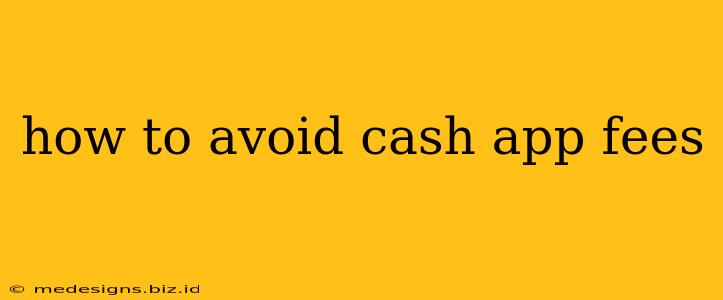Cash App has become incredibly popular for its ease of sending and receiving money. However, those convenient features sometimes come with fees. This guide will explore the various fees associated with Cash App and provide practical strategies to minimize or completely avoid them. Understanding these nuances can save you a significant amount of money over time.
Understanding Cash App Fees
Before we dive into how to avoid them, let's identify the primary fees you might encounter:
1. Instant Deposit Fees:
Cash App offers instant deposit options for your direct deposits or receiving money. However, choosing this speed often comes with a fee. The fee varies depending on the amount deposited and can be a significant percentage. To avoid this, opt for the standard deposit which is typically free but takes 1-3 business days.
2. Cash App Card Fees:
Using your Cash App card for purchases at ATMs or specific retailers might result in fees. Check your Cash App Card's terms and conditions to fully understand any associated charges. Look for fee-free ATMs within your network to save money.
3. Sending Money to a Non-Cash App User:
Sending money to someone who doesn't have a Cash App account often involves a fee for the recipient. This fee is typically a percentage of the transaction. To avoid this fee, encourage your recipients to download and create a Cash App account. Alternatively, explore other fee-free money transfer services.
4. Bitcoin Fees:
If you use Cash App for buying or selling Bitcoin, be aware of transaction fees that can fluctuate based on network activity. These fees are applied to the overall transaction. Carefully monitor these fees before making a trade.
Strategies to Avoid Cash App Fees
Now that we've identified the potential fees, let's discuss practical strategies to minimize or eliminate them entirely:
1. Embrace the Standard Deposit:
For receiving money, always choose the standard deposit option. It's free and only requires a small amount of patience. The extra few days are worth the savings.
2. Use Your Cash App Card Wisely:
Be mindful of where you use your Cash App card. Utilize fee-free ATMs whenever possible. Read the terms associated with your card to identify any potential hidden fees related to specific purchases.
3. Encourage Cash App Usage Among Contacts:
By persuading those you frequently send money to use Cash App, you avoid the fees associated with transactions to non-users. This simple step can result in significant savings over time.
4. Monitor Bitcoin Transaction Fees:
When using the Cash App's Bitcoin feature, diligently monitor the transaction fees displayed before confirming your purchase or sale. Choose times with lower fees for maximum savings.
5. Plan Your Transactions:
Before making any transfer, review the details to confirm there are no hidden fees. A little planning goes a long way in saving money.
Beyond Cash App: Alternative Money Transfer Options
While Cash App offers convenience, other options exist that might suit your needs better, depending on the circumstances:
- PayPal: Another widely used platform, often with similar fee structures to Cash App. Carefully review their fee schedule before use.
- Zelle: A popular peer-to-peer payment app integrated into many banks' online platforms, often offering fee-free transfers between enrolled users.
- Venmo: A popular social payment app with a similar functionality to Cash App. Evaluate its fees and determine if it is a better fit for your financial needs.
Conclusion: Smart Usage = Money Saved
Cash App can be a valuable tool, but understanding its fee structure is crucial for cost-effective usage. By strategically utilizing the platform and understanding the alternatives, you can minimize or completely avoid unnecessary fees. Remember, a little awareness can save you a lot of money in the long run.
